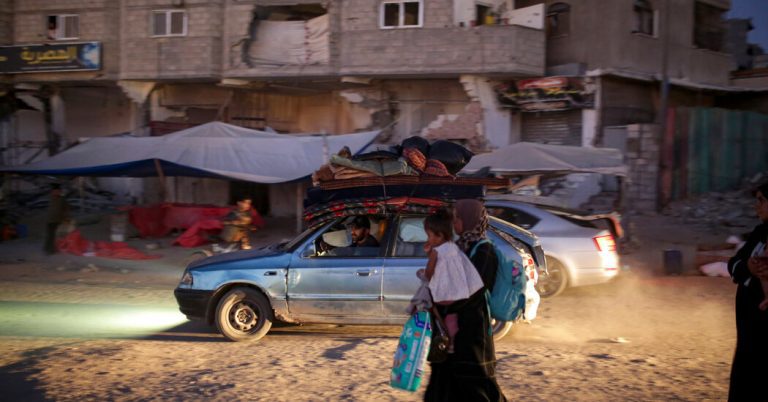The Israeli army ordered new evacuations on Monday for areas of southeastern Gaza in the outskirts of Khan Younis and Rafah. Such orders are usually an indication that the military is planning a ground attack.
Doctors at the European Hospital in Gaza, near Khan Younis, said they had also received orders to evacuate. The Israeli military did not respond to a request for comment on the order to evacuate the hospital.
An evacuation notice posted on social media by the Israeli military’s spokesman for Arab media, Avichay Adraee, said people in the designated areas “must evacuate immediately” for their safety.
Source: Israeli military communications
By Leanne Abraham
Large areas of Khan Younis were flattened during a wide-ranging offensive earlier this year, after which Israeli forces withdrew, claiming to have destroyed Hamas battalions there. But Israeli commanders have repeatedly sent troops back into areas they were supposed to have secured to destroy resurgent pockets of Hamas militants.
The evacuation order was announced after the Israeli military reported at least 20 rockets fired from southern Gaza into Israel and said it fired artillery in response, hitting the sources of the rockets.
Most of Gaza’s population of about 2.2 million have been displaced during the war. Many people were forced to flee repeatedly following evacuation orders or to escape the fighting.
The United Nations condemned Monday’s evacuation order. “It shows once again that no place is safe in Gaza,” Stephane Dujarric, a spokesman for the UN secretary-general, told reporters in New York, adding that the announcement underscored the need for a ceasefire. “It is yet another stop in this deadly circular motion that the population of Gaza must undergo on a regular basis,” he added.
Dr. Mohammed Harara, an emergency physician at the European Hospital in Gaza, shared videos with The New York Times on Monday that showed injured patients at the hospital being carried on stretchers and others being wheeled out, with rooms in disarray from the hasty evacuations. He estimated there were about 600 patients in the hospital and said he was still there working on evacuations.
In a message sent early Tuesday, Dr. Harara said he could hear shelling very close by and that injured patients were arriving at the hospital, despite an evacuation order.
A doctor at Nasser Hospital, about six miles away, reported “massive chaos” and fistfights in the emergency room as ambulances arrived with patients from Gaza’s European Hospital, who had to compete for care with incoming patients from the region.
The doctor, Hina Cheema, a Pakistani-American on a humanitarian mission in Nasser, said evacuations were complicated because roads in the area had been mostly destroyed and were now filled with people fleeing and unstable patients were at risk of dying. during transport. The drive from Gaza’s European Hospital to Nasser takes about 30 minutes under current conditions, both she and Dr. Harara said.
There were about 300 to 400 beds at the European Hospital in Gaza, said Shéhérazade Kaoues, a spokeswoman for FAJR Scientific, a US-based nonprofit group that organizes humanitarian medical missions to Gaza. But many more patients and evacuees had taken refuge there before the evacuation order came, he said.
Ms Kaoues said her organization had three foreign medical volunteers in European Gaza, but that they had all been evacuated to a safe house.
In May, a group of about 16 international health care workers were trapped in the European Hospital in Gaza for about two weeks after Israel seized the Rafah border crossing near Egypt. At the time, there were no evacuation orders for the hospital, said Adam Hamawi, an American doctor at the hospital at the time. He wrote to President Biden about the dire danger in Gaza, saying no one is safe, including civilians and aid workers.
One of the doctors trapped in the European Gaza Strip in May, Dr. Mohamed Tahir, is an orthopedic and peripheral nerve surgeon from Britain who is now on his second medical mission with Fajr Scientific at the European Hospital in Gaza. On Monday, he said he had been evacuated to a safe house. In a video posted on social media and shared with the Times, he said: “My feelings are those of disbelief, of disappointment, of sadness. I’ve literally left my patients back at EGH, I don’t know who’s going to take care of them.”
He described working on patients with complex injuries before his discharge, including bone infections, and said he was unsure of their fate. “These people will get sick very quickly and probably die within a few days,” he said.
Neil MacFarquhar contributed to the report.




